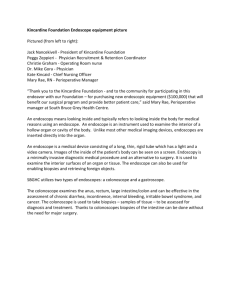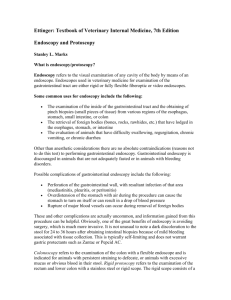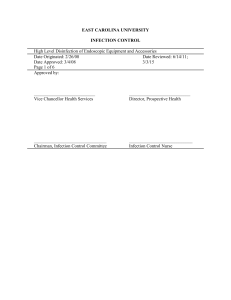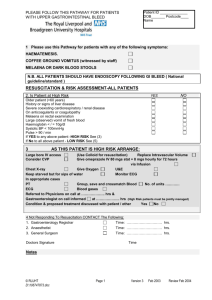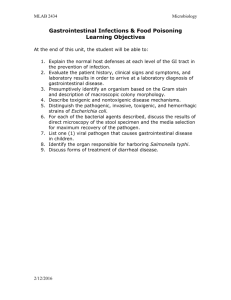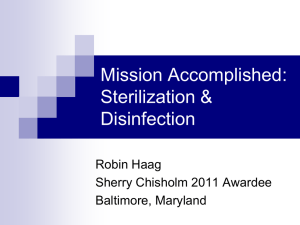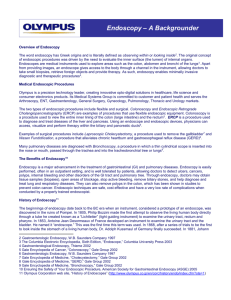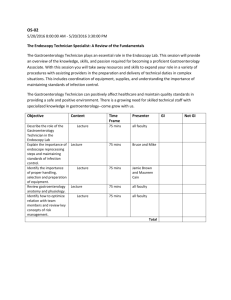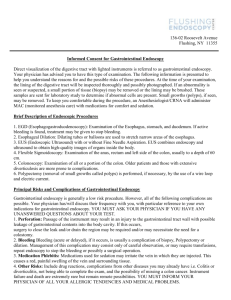Standards of Infection Control in Reprocessing of Flexible Gastrointestinal Endoscopes
advertisement
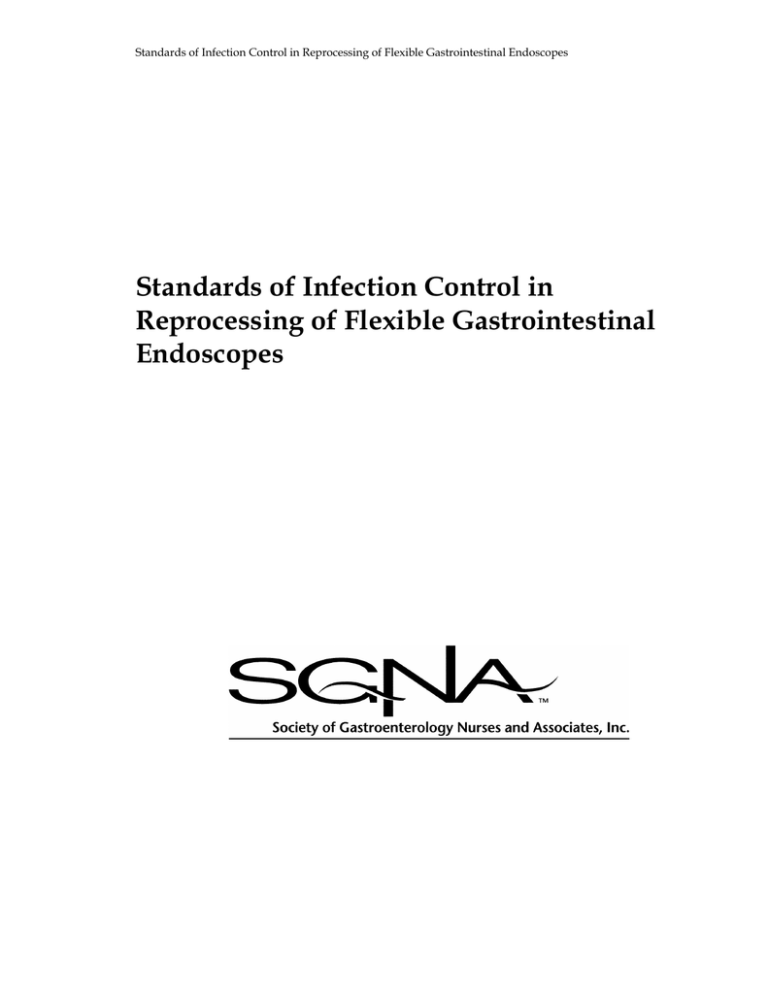
Standards of Infection Control in Reprocessing of Flexible Gastrointestinal Endoscopes Standards of Infection Control in Reprocessing of Flexible Gastrointestinal Endoscopes Standards of Infection Control in Reprocessing of Flexible Gastrointestinal Endoscopes Acknowledgements Copyright © 2012, Society of Gastroenterology Nurses and Associates, Inc. (SGNA). First published in 1996, revised 2000, 2005, 2007, 2008, 2012. This document was prepared and written by the members of SGNA Practice Committee and adopted by the SGNA Board of Directors in 2012. It is published as a service to SGNA members. SGNA Practice Committee 2011 – 12 Michelle E. Day MSN BSN RN CGRN Chair Michelle Juan MSN ACNS-BC RN CGRN Co Chair Kathy Buffington BSN RN CGRN Rhonda L. Casey RN BS MHA CGRN Cynthia M. Friis MEd BSN RN-BC Ann Herrin, BSN RN CGRN Colleen Kelley Keith MSN RN CGRN Judy Lindsay MA BSN RN CGRN Marilee Schmelzer PhD RN Barbara Zuccala MSN RN CGRN Reprints are available for purchase from SGNA Headquarters. To order, contact: Department of Membership Services Society of Gastroenterology Nurses and Associates, Inc. 401 N. Michigan Avenue Chicago, IL 60611-4267 Tel: (800) 245-SGNA or (312) 321-5165 Fax: (312) 673-6694 Online: www.SGNA.org Email: SGNA@smithbucklin.com Disclaimer The Society of Gastroenterology Nurses and Associates, Inc. present this guideline for use in developing institutional policies, procedures, and/or protocols. Information contained in this guideline is based on current published data and current practice at the time of publication. The Society of Gastroenterology Nurses and Associates, Inc. assume no responsibility for the practices or recommendations of any member or other practitioner, or for the policies and practices of any practice setting. Nurses and associates function within the limits of state licensure, state nurse practice act, and/or institutional policy. 2 Standards of Infection Control in Reprocessing of Flexible Gastrointestinal Endoscopes Table of Contents Preface……………………………………………………….…………………………………….4 Definitions…………………………………………………………………………………………4 Introduction………………………………………………………………………………………..6 Personnel…………………………………………………………………………………………...6 Education & Training……………………………………………………………………………..6 Quality Assurance………………………………………………………………………………....7 Procedure Rooms………………………………………………………………………………….8 Reprocessing Rooms………………………………………………………………………………9 Spill Containment Plan……………………………………………………………………………9 Accessories………………………………………………………………………………………..10 Infection Control Measures.……………………………………………………………………..10 Endoscope Reprocessing Protocol………………………………………………………………10 References…………………………………………………………………………………………20 Standards of Infection Control in Reprocessing of Flexible Gastrointestinal Endoscopes Preface These standards are presented by the Society of Gastroenterology Nurses and Associates, Inc. (SGNA) to be used for all settings where gastrointestinal endoscopy is practiced. These standards have been developed to complement the position statement, Reprocessing of Flexible Gastrointestinal Endoscopes-An American Society for Gastrointestinal Endoscopy White Paper (Walter, 1996) and developed by the American Society for Gastrointestinal Endoscopy (ASGE), Association for Professionals in Infection Control and Epidemiology (APIC), and SGNA. The current version complements SGNA's (2009) Guideline for the Use of High Level Disinfectants and Sterilants for Reprocessing of Flexible Gastrointestinal Endoscopes. Proper reprocessing of endoscopes and accessories is critical to the safe and successful treatment of patients (American Society for Gastrointestinal Endoscopy [ASGE], 2008). The SGNA and ASGE support increased research in the areas of endoscope design and encourage manufacturers to develop flexible gastrointestinal endoscopes that can be easily disassembled for reprocessing and verification of cleaning and high level disinfection. The use of nonimmersible endoscopes is no longer acceptable because endoscopes that cannot be completely immersed in liquid cannot be adequately cleaned and high-level disinfected (Rutala & Weber, 2004). Endoscopes reprocessed appropriately in accordance with reprocessing and infection control guidelines pose virtually no risk of transmission of patient-borne or environmental microorganisms. In the absence of defective equipment, every reported case of hospital acquired infection associated with a contaminated gastrointestinal (GI) endoscope has been linked to a breach or violation of at least one of several requisite reprocessing steps (Nelson & Muscarella, 2006). The United States Food and Drug Administration (FDA) has approved labeling for some automated endoscope reprocessors. The labeling clears these machines as washer-disinfectors which do not require prior manual cleaning and channel brushing. However, bedside pre-cleaning is still required. While the introduction of automated, brushless washing of endoscope channels represents a potentially significant advancement, the existing multi-society guideline (American Society for Gastrointestinal Endoscopy Quality Assurance in Endoscopy Committee et al., 2011) and other international standards emphasize the importance of manual cleaning and brushing for the overall efficacy of high level disinfection (HLD). The redundancy achieved by adding an automated washing step following manual cleaning can undoubtedly provide an extra level of safety. Users are cautioned about dispensing with manual cleaning endoscope reprocessing and brushing steps before the capabilities of the new machines are confirmed in independent studies and in clinical practice (Alfa, Olson, & DeGagne, 2006; ASGE, 2008). Diligence in application of all steps of reprocessing remains paramount in the safe delivery of endoscopic services. Definitions For the purpose of this document, SGNA adopted the following definitions: Standards of Infection Control in Reprocessing of Flexible Gastrointestinal Endoscopes Anionic detergent: A type of surfactant (see surfactant definition below). Automated endoscope reprocessor (AER) refers to machines designed for the purpose of cleaning and disinfecting endoscopes and accessories. Meticulous manual cleaning must precede the use of AERs (American Society for Gastrointestinal Endoscopy Quality Assurance in Endoscopy Committee et al., 2011). Biofilm refers to a matrix of different types of bacteria and extracellular material that can tightly adhere to the interior surfaces of endoscopes (Association for the Advancement of Medical Instrumentation [AAMI], 2010; Miner, Harris, Ebron, & Cao, 2007). Endoscope refers a tubular instrument used to examine the interior of the hollow viscera. In this document, endoscope refers only to flexible gastrointestinal endoscopes. Enzymatic detergent refers to low-foaming detergents which add enzymes capable of digesting organic material such as blood and mucous. High-level disinfectant refers to a chemical germicide that has been cleared by the FDA as capable of destroying all viruses, vegetative bacteria, fungi, mycobacterium and some, but not all, bacterial spores (Rutala, 1996). High-level disinfection (HLD) refers to the destruction of all microorganisms with the exception of low levels of bacterial spores (Rutala, Weber, & the Healthcare Infection Control Practices Advisory Committee [HICPAC], 2008). Material Safety Data Sheet (MSDS) refers to a descriptive sheet that accompanies a chemical or chemical mixture and provides information regarding the identity of the material; physical hazards, such as flammability; and acute and chronic health hazards associated with contact with or exposure to the compound. Minimum effective concentration (MEC) refers to the lowest concentration of active ingredient necessary to meet the label claim of a reusable high-level disinfectant/sterilant (AAMI, 2010). Reprocessing refers to the validated process of cleaning, disinfecting, or sterilizing endoscopes and accessories. Reuse life refers to a statement by the manufacturer indicating the maximum number of days a reusable high-level disinfectant/sterilant might be effective (AAMI, 2010). Sterilant refers to a chemical germicide that has been cleared by the FDA as capable of destroying all microorganisms, including all bacterial spores (Rutala, Standards of Infection Control in Reprocessing of Flexible Gastrointestinal Endoscopes 1996; OSHA, 2012). Sterile refers to the state of being free from viable microorganisms (AAMI, 2010). Sterilization refers to a process resulting in the complete elimination or destruction of all forms of microbial life. The Spaulding Classification identifies sterilization as the standard for medical devices (e.g., biopsy forceps) that enter the vascular system or sterile tissue (World Health Organization [WHO], 2004). Surfactant is a substance that has both a hydrophilic group and a hydrophobic group. Surfactants are a broad class of molecules that function to bind and lift soil. They may be natural such as soap (anionic) or synthetic, derived from petroleum products. Some types of surfactants serve as wetting agents to lower the surface tension of the cleaning solution (Kern, 2001). Introduction The field of gastroenterology continues to expand as new instruments, products, and procedures are introduced into the endoscopy arena. While the transmission of infectious organisms during gastrointestinal endoscopy is considered rare, 1 in 1.8 million cases (ASGE, 2008), the need for continued emphasis on infection control issues remains paramount. Failure to adhere to established reprocessing guidelines or the use of defective equipment accounts for all of the reported cases of bacterial and viral transmissions (American Society for Gastrointestinal Endoscopy Quality Assurance in Endoscopy Committee et al., 2011). The Spaulding classification system is universally used to determine what type of disinfection or sterilization is appropriate for medical devices (American Society for Gastrointestinal Endoscopy Quality Assurance in Endoscopy Committee et al., 2011). These 3 classes, critical, semi-critical and non-critical, stratify the risk of infection associated with each device. Critical devices break the mucosal barrier and should be sterilized (e.g., reusable biopsy forceps). Semi-critical devices (e.g., endoscopes) come in contact with mucous membranes or non-intact skin and should be sterilized or receive high level disinfection. Non-critical devices are those that come into contact with intact skin such as blood pressure cuffs and stethoscopes. These items can be cleaned with soap and water or disinfected with a germicide. Endoscopes are considered semi-critical and should receive high level disinfection with a FDA approved high level disinfectant (American Society for Gastrointestinal Endoscopy Quality Assurance in Endoscopy Committee et al., 2011). Complex endoscope design features may allow organic debris and microorganisms to accumulate, making manual cleaning essential. Biofilm formation may harbor microorganisms, making strict and meticulous adherence to reprocessing guidelines imperative in order to prevent cross-contamination between patients or hospital-acquired infections (Alvarado & Reichelderfer, 2000). Prompt efficient cleaning processes are the best defense against biofilm formation (Nelson, 2005). 6 Standards of Infection Control in Reprocessing of Flexible Gastrointestinal Endoscopes The following topics require specific adherence to infection control principles which are based on the current literature and professional standards. Personnel Only individuals, who are able to read, understand, and implement instructions on the proper cleaning and high level disinfection of gastrointestinal endoscopes and accessories should be given the responsibility to reprocess such instruments (American Society for Testing and Materials [ASTM], 2007; AAMI, 2010). These individuals must meet competency standards for endoscope reprocessing (AAMI, 2010). Temporary personnel should not be allowed to clean or disinfect instruments in either a manual or an automated reprocessing system until competency has been established (American Society for Gastrointestinal Endoscopy Quality Assurance in Endoscopy Committee et al., 2011). Education and Training All staff in any setting where gastrointestinal endoscopy is performed must adhere to infection control principles that will maintain a safe environment, free from the possibility of spreading disease to patients and co-workers. This is true regardless of the setting (hospital, clinic, ambulatory care center, and office), relative to any and all types of gastrointestinal (GI) procedures performed. Each individual who reprocesses instruments should complete the initial infection control orientation and reprocessing competency. Competency review and infection control updates should be validated and documented annually (American Society for Gastrointestinal Endoscopy Quality Assurance in Endoscopy Committee et al., 2011; ASTM, 2007). According to ASTM (2007), the core components of an education program should cover the following topics: 1. Standard precautions, 2. Personal protective equipment, 3. OSHA rules on occupational exposure to blood-borne pathogens, 4. Reprocessing procedures for endoscopes and accessory equipment, 5. Mechanisms of disease transmission, 6. Maintenance of a safe work environment, 7. Safe handling of high level disinfectants and sterilants, and 8. Procedures for waste management. Flexible endoscope reprocessing has been shown to have a narrow margin of safety. Any slight deviation from the recommended reprocessing protocol can lead to the survival of microorganisms and an increased risk of infection (Alfa et al., 2006). Training with documented competency must be completed for new models of endoscopes, accessories, valves, and automatic endoscope reprocessors as they are introduced in the facility. Annual updates are recommended to ensure Standards of Infection Control in Reprocessing of Flexible Gastrointestinal Endoscopes compliance with current standards and manufacturers’ guidelines (Rutala & Weber, 2004; Rutala et al., 2008). Decisions must be made in each endoscopy setting regarding the number and category of personnel that will be responsible for instrument reprocessing. All persons involved must be properly trained and their performance subject to periodic review and continuing education. All individuals who reprocess endoscopes and accessories require detailed knowledge of the instruments and the specific methods required to produce an instrument safe for use. This knowledge is developed through repetition and the guidance of a preceptor. Quality Assurance Quality assurance is of the highest priority in settings where gastrointestinal endoscopy is performed. Such settings must have an effective quality assurance program with special emphasis on cleaning and high level disinfection of flexible endoscopes. Elements of the quality assurance program include supervision, training, annual competency review, methods of assuring the availability of appropriate equipment and supplies, and procedures for reporting infections (ASTM, 2007; AAMI, 2010; Rutala et al., 2008). Supervisory personnel must be familiar with the principles and practices of instrument reprocessing if they are to properly train and monitor staff. Knowledgeable supervisors also serve to impress upon peer groups and subordinates the importance of these functions. Strict adherence to the reprocessing protocol is essential for safety. This protocol should be reviewed and updated according to institutional policy. Consultation with an infection control advisor should be considered when modifications to the reprocessing protocol are made. An individual in the endoscopy setting should be designated and assigned to monitor compliance with the reprocessing protocol (SGNA, 2009). The competency of each individual involved in reprocessing should be evaluated at least annually (Rutala et al., 2008; SGNA, 2009). Staff should monitor reusable high level disinfectants and sterilants for minimum effective concentrations according to the label on the test strips and maintain a log of results (SGNA, 2009). High level disinfectants and sterilants must be changed when the solutions fail to meet minimum effective concentration or exceed the high level disinfectants’ manufacturer’s recommended reuse life, whichever comes first (ASGE, 2008; American Society for Gastrointestinal Endoscopy Quality Assurance in Endoscopy Committee et al., 2011). In addition there should be an established program for monitoring occupational exposure to regulated chemicals (e.g., formaldehyde, EtO) which adheres to state 8 Standards of Infection Control in Reprocessing of Flexible Gastrointestinal Endoscopes and federal regulations (Rutala et al., 2008). For additional information, refer to SGNA’s (2009) Guideline for the Use of High Level Disinfectants and Sterilants for Reprocessing of Flexible Gastrointestinal Endoscopes. A preventive maintenance plan should be in place for all automated reprocessors. Quality controls recommended by manufacturers of automated endoscope reprocessors (AER) should be adhered to and documented. As part of a quality control program, documentation may include, but is not limited to the following (American Society for Gastrointestinal Endoscopy Quality Assurance in Endoscopy Committee et al., 2011): 1. the procedure date and time, 2. the patient’s name and medical record number, 3. the endoscopist, 4. the endoscope’s model and serial number or other identifier, 5. the AER (if used) model and serial number or other identifier, and 6. the staff member(s) reprocessing the endoscope. Report any suspected or identified infections to those responsible for infection control in the endoscopy setting. The routine culturing of endoscopes is not currently recommended, but may be done in the event of an identified outbreak (American Society for Gastrointestinal Endoscopy Quality Assurance in Endoscopy Committee et al., 2011). Procedure Rooms To prevent cross-contamination in an endoscopic procedure room, most areas of the room should be designated as clean areas. Contaminated areas where accessories and specimens are handled should be separated from clean counter areas. All contaminated areas must be cleaned and decontaminated between patients with an Environmental Protection Agency (EPA) registered, hospitalgrade disinfectant appropriate for the specific microorganism (Rey et al., 2005; Rutala et al., 2008). Reprocessing Room Reprocessing of contaminated patient equipment must be done in an area designated and dedicated for this function. This must be a room separate from where endoscopic procedures are performed (AAMI, 2010). Current local and state codes and federal guidelines should be incorporated in the design of any reprocessing area. Considerations include adequate space for reprocessing activities, proper airflow and ventilation requirements, work flow patterns, work surfaces, lighting, adequate utilities such as electrical support and water, hand washing and eye washing facilities, air drying capability, and storage. Tap water and/or water that has been filtered by passage through a 0.2 micron filter or water of equivalent quality (i.e., suitable for drinking) should be available in the reprocessing area (American Society for Gastrointestinal Endoscopy Quality Assurance in Endoscopy Committee et al., 2011; Rutala & Standards of Infection Control in Reprocessing of Flexible Gastrointestinal Endoscopes Weber, 2004). Bottled sterile water may be used. Manual cleaning includes using a medical grade, low-foaming, neutral pH detergent formulated for endoscopes that may or may not contain enzymes (ASTM, 2007; Marion et al., 2006). Refer to endoscope manufacturer’s reprocessing manual for additional information. A Food and Drug Administration (FDA) cleared high-level disinfectant or sterilant, and 70% isopropyl alcohol is needed in the reprocessing room for high level disinfection. An EPA-registered hospital-grade disinfectant should be used for surface cleaning appropriate for the specific microorganism (ASTM, 2007). Spill Containment Plan Each endoscopy setting should have a spill containment plan for the chemicals used in their area. The plan must include information from the specific Material Safety Data Sheet. The plan should include written procedures for actions to contain the spill and deactivate the chemical, an intra- and inter-departmental communication plan, and an evacuation plan. Upon assignment to the department and annually thereafter, all persons working in the setting must be trained in the safe handling of high-level disinfectants or sterilants, and spill containment procedures. Refer to the manufacturer’s instructions for information on the specific solution. Accessories The FDA requires manufacturers of reusable devices to provide instructions for cleaning and high-level disinfection or sterilization (American Society for Gastrointestinal Endoscopy Quality Assurance in Endoscopy Committee et al., 2011). Refer to the manufacturer’s guidelines for specifics on reprocessing of endoscopic accessories. Accessories which are classified as critical devices (those which break the mucus membrane and/or come into contact with sterile tissue or the vascular system) require sterilization. Accessories labeled for single-use must not be reprocessed and/or reused (Rutala, 1996; SGNA, 2009). Infection Control Measures Every patient must be considered a potential source of infection and all endoscopes must be decontaminated with the same degree of rigor following every endoscopic procedure. Lack of knowledge or unfamiliarity with endoscope channels, accessories, and specific steps required for reprocessing has been linked to a risk of infection transmission (American Society for Gastrointestinal Endoscopy Quality Assurance in Endoscopy Committee et al., 2011). Infection control measures that can disrupt the chain of infection include (Rey et al., 2005): 1. disinfection and sterilization of medical equipment, 2. proper use of personal protective equipment, 10 Standards of Infection Control in Reprocessing of Flexible Gastrointestinal Endoscopes 3. 4. 5. 6. 7. 8. personal hygiene, engineering controls (ventilation, room design, water supply), cleaning and disinfection of environmental surfaces, administrative monitoring and support, training and continuing education, and written protocols. Endoscope Reprocessing Protocol The reprocessing protocol presented here outlines basic steps to clean and perform high-level disinfection of gastrointestinal endoscopes. Endoscope manufacturers’ instructions must always be consulted for design features unique to a particular instrument, which may require specific reprocessing detail (SGNA, 2009). Guidelines for endoscope reprocessing prescribe the following steps (Rey et al., 2005; SGNA, 2009): 1. precleaning, 2. leak testing, 3. manual cleaning, 4. rinse after cleaning, 5. high level disinfection,(manual or automated) 6. rinse after high level disinfection, 7. drying, and 8. storage. 1. PRECLEANING The initial steps in the reprocessing protocol begin in the procedure room immediately after removal of the insertion tube from the patient and prior to disconnecting the endoscope from the power source. Pre-cleaning should be performed at point of use, before bioburden has an opportunity to dry and before complete decontamination (American Society for Gastrointestinal Endoscopy Quality Assurance in Endoscopy Committee et al., 2011). a. Have the following available: 1) personal protective equipment (gloves, eye protection, impervious gown, face shield or simple surgical mask that will not trap vapors), 2) container with detergent solution, 3) sponge or soft, lint-free cloth, 4) air and water channel cleaning adapters per manufacturer's instruction, and 5) protective video caps if using video endoscopes. b. Immediately after removing the endoscope from the patient, wipe the insertion tube with the wet cloth or sponge soaked in the freshly prepared detergent solution. Note that the cloth/sponge should be disposed of, sterilized, or high-level disinfected between cases (Rutala & Weber, 2004). Standards of Infection Control in Reprocessing of Flexible Gastrointestinal Endoscopes c. Place the distal end of the endoscope into the appropriate detergent solution and suction a large volume of detergent solution through the endoscope until clear (American Society for Gastrointestinal Endoscopy Quality Assurance in Endoscopy Committee et al., 2011). Finish by suctioning air. d. Flush air and water channels in accordance with the endoscope manufacturer's instructions. e. Flush the auxiliary water channel per manufacturer’s instructions. f. Detach the endoscope from the light source and suction pump. g. Attach protective video cap if using video endoscope. h. Transport the soiled endoscope to the reprocessing area in a closed container that prevents exposure to staff, patients, or the environment to potentially infectious organisms (American Society for Gastrointestinal Endoscopy Quality Assurance in Endoscopy Committee et al., 2011). Containers, sinks, and basins should be large enough that the endoscope will not be damaged by being coiled too tightly. Reprocessing should occur in a room separate from the procedure room. Note: THE FOLLOWING STEPS OCCUR IN THE REPROCESSING AREA Have the following available: a. personal protective equipment (gloves, eye protection, impervious gown, face shield or simple surgical mask that will not trap vapors), b. leak-testing equipment, c. channel cleaning adapters (per manufacturer's instructions), d. large basin or sink, e. detergent solution prepared according to manufacturer's instructions, f. appropriate size channel cleaning brushes, and g. sponge and/or lint-free cloth. 2. LEAK TESTING Leak testing detects damage to the interior or exterior of the endoscope. The leak test is done before immersion of the endoscope in reprocessing solutions to minimize damage to parts of the endoscope not designed for fluid exposure. Leak test the endoscope following manufacturer's instructions. a. Manual leak testing 1) Remove suction valves, air water valves, and biopsy valves Discard those parts that are designated as disposable. Note that the endoscope must be completely disassembled so that all surfaces may be reached for thorough cleaning. 12 Standards of Infection Control in Reprocessing of Flexible Gastrointestinal Endoscopes 2) Attach the leak tester and pressurize the scope before submerging it in clear water. Detergent is never added to water before or during leak testing. Detergent will obscure bubbles leaking from the endoscope and a leak may be missed. Refer to specific manufacturer’s instructions to determine if it is necessary to remove other detachable parts before leak testing. 3) With the pressurized endoscope completely submerged, flex the distal portion of the scope in all directions, observing for bubbles. Depress the freeze and release buttons while observing the control head of the scope for bubbles. Check the insertion tube and distal bending section as well as the universal cord for bubbles coming from the interior of the scope. 4) Remove endoscope from sink or basin. Turn off leak tester. Disconnect leak tester from video cap. Allow endoscope to depressurize. Ensure video cap is secure and has not loosened with removal of leak tester. Continue with reprocessing steps when test is complete unless a leak is detected. b. Computerized leak testing 1) Remove suction valves, air water valves, and biopsy valves. 2) Attach the leak tester to the computer. 3) Input data including scope ID and user. 4) Move knobs and depress the freeze and release buttons when indicated. 5) Continue with reprocessing steps when test is complete unless a leak is detected. c. Follow the endoscope manufacturer's instructions if a leak or high humidity is detected or if the endoscope appears damaged. Note: CLEANING SOLUTIONS The composition of soil found on endoscopes includes, proteins, fats, carbohydrates and the various chemical salts that exist in blood and other body fluids. Ideally, a cleaning solution should have a broad spectrum of effectiveness against these various contaminants and not harm the device being cleaned. The ideal solution would combine the benefits of water and organic solvents and also be able to penetrate and lift soil from the instrument suspending it in solution (Kern, 2001). Enzymatic cleaning solutions use surfactants to break down and digest bioburden. They are specifically selected to have a negligible effect on surface tension while still suspending soil particles. This feature provides easy rinsibility. Specific product labeling will define the time required for this enzyme activity to take place and must be incorporated into the cleaning process. Comparatively, some anionic detergents rely solely on mechanical action for Standards of Infection Control in Reprocessing of Flexible Gastrointestinal Endoscopes removal of bioburden, others are bacteriocidal. This capacity to kill microorganisms and to clean patient soil from endoscopes would also provide protection for healthcare workers (Marion et al., 2006). 3. MANUAL CLEANING Manual cleaning of endoscopes is necessary prior to automated or manual disinfection. This is the most important step in removing the microbial burden from an endoscope. Retained debris may inactivate or interfere with the capability of the active ingredient of the chemical solution to effectively kill and/or inactivate microorganisms. a. Fill a sink or basin with freshly-made solution of water and a medical grade, low-foaming, neutral pH detergent formulated for endoscopes that may or may not contain enzymes (ASTM, 2007; Marion et al., 2006). b. Dilute and use according to the detergent manufacturer's instructions. Note that: 1) Freshly prepared detergent solution should be used for each endoscope to prevent cross-contamination. 2) Low-foaming detergents are recommended such that the device can be clearly visualized during the cleaning process, preventing personnel injury and allowing for complete cleaning of lumen surfaces. Excessive foaming can inhibit good fluid contact with the device surfaces. 3) Endoscopes exposed to synthetic lipids may require additional pre-cleaning with a detergent formulated to remove synthetic lipids. c. Ensure video cap is secure. Immerse the endoscope. d. Wash all debris from the exterior of the endoscope by brushing and wiping the instrument while submerged in the detergent solution. The endoscope should be submerged in the detergent solution when performing all subsequent cleaning steps to prevent splashing of contaminated fluid and aerosolization of bioburden. e. Use a small, soft brush to clean all removable parts, including inside and under the suction valve, air/water valve, and biopsy port cover and openings. Use non-abrasive and lint-free cleaning tools to prevent damage to the endoscope. f. Brush all accessible endoscope channels including the body, insertion tube and the umbilicus of the endoscope. Use a brush size compatible with each channel. Be knowledgeable of the specific instructions for each model of endoscopes. 14 Standards of Infection Control in Reprocessing of Flexible Gastrointestinal Endoscopes g. After each passage, rinse the brush in the detergent solution, removing any visible debris before retracting and reinserting it. h. Continue brushing until there is no debris visible on the brush. i. Clean and high-level disinfect reusable brushes between cases. Note that reusable brushes should be inspected between uses and replaced when worn, frayed, bent, or otherwise damaged. Worn bristles are ineffective in cleaning, and damaged brushes may damage endoscope channels. j. Attach the endoscope manufacturer’s cleaning adapters for suction, biopsy, air, and water channels. Note: Automated pumps are available for this step that eliminate the manual flush. Refer to manufacturer’s guidelines for the use of these devices as well as endoscopes compatible for use of the device. k. Attach the manufacturer’s cleaning adapters for special endoscope channels (e.g., elevator channel, auxillary channel, and doublechannel scopes). 1) To achieve adequate flow through all lumens, various adapters or channel restrictors may be required. Refer to the manufacturer's instructions. 2) Because the elevator channel of a duodenoscope is a small lumen, this channel requires manual reprocessing (all steps) using a 2- to 5-milliliter syringe (American Society for Gastrointestinal Endoscopy Quality Assurance in Endoscopy Committee et al., 2011). 3) Other specialty endoscopes such as endonoscope (EUS), endoscopic retrograde cholangiopancreatography (ERCP), and double balloon endoscopes may require additional steps to adequately clean manually refer to specific manufacturer’s instructions. l. Flush all channels with the detergent solution to remove debris. m. Soak the endoscope and its internal channels for the period of time specified by the label, if using an enzymatic detergent. Note: All steps should be completed sequentially and immediately following the procedure. If this is not possible refer to manufacturer’s recommendations. 4. RINSE AFTER MANUAL CLEANING a. Thoroughly rinse the endoscope and all removable parts with clean Standards of Infection Control in Reprocessing of Flexible Gastrointestinal Endoscopes water to remove residual debris and detergent. b. Purge water from all channels using forced air. Dry the exterior of the endoscope with a soft, lint-free cloth to prevent dilution of the liquid chemical germicide used in subsequent steps. 5. HIGH LEVEL DISINFECTION High level disinfection (HLD) is recognized as the standard for reprocessing of gastrointestinal endoscopes by SGNA, the American Society for Gastrointestinal Endoscopy (ASGE), the American College of Gastroenterology (ACG), the American Gastroenterological Association (AGA), the Association for Professionals in Infection Control and Epidemiology (APIC), and ASTM. Agencies such as the Centers for Disease Control and Prevention (CDC) and The Joint Commission (JC) recognize HLD as appropriate for gastrointestinal endoscopes. Sterilization of endoscopes is indicated in the rare occasions when it is used as a critical medical device, where there is potential for contamination of an open surgical field (American Society for Gastrointestinal Endoscopy Quality Assurance in Endoscopy Committee et al., 2011). HLD destroys all viable microorganisms, but not necessarily all bacterial spores (AAMI, 2010). The high-level disinfectant or sterilant used should be prepared in accordance with manufacturer's directions. Because most highlevel disinfectants/sterilants are typically reused, they must be tested to assure that they remain above their minimum effective concentration (MEC). Refer to the Guideline for the Use of High Level Disinfectants and Sterilants for Reprocessing of Flexible Gastrointestinal Endoscopes (SGNA, 2009) for additional information on this topic. Follow disinfectant/sterilant manufacturer's recommendations for concentration and temperature to achieve high-level disinfection of endoscopes. High level disinfection can be achieved either manually or automated by using an automated endoscope reprocessor (AER). To use high-level disinfectants and sterilants: 1. Prepare the product according to disinfectant/sterilant manufacturer's label instructions. 2. Test the product for the MEC according to the label on the test strip container. Note that: a. The reuse life of a reusable high-level disinfectant/sterilant is related to several factors including, but not limited to, dilution, time/temperature, and number of uses. It is essential that the level of active ingredient be at or above that required to kill and/or inactivate 16 Standards of Infection Control in Reprocessing of Flexible Gastrointestinal Endoscopes the desired microorganisms (AAMI, 2010). b. Some chemical test strips recommend the use of quality-control procedures to ensure the strips perform properly, if recommended the user should follow manufacturer’s instructions (Rutala et al., 2008). 3. The MEC may never be used to extend the reuse life claim of the product. The MEC may never be used beyond the date specified on activation (Rutala et al., 2008). 4. Use a product-specific test strip, and keep a log of the test results (Rutala et al., 2008). 5A. MANUAL HIGH LEVEL DISINFECTION 1. Completely immerse the endoscope and all removable parts in a basin of high-level disinfectant/sterilant. a. The basin must be of a size to accommodate the endoscope without undue coiling, and must have a tight-fitting lid to contain the chemical vapors (ASGE, 2001). b. To prevent damage to the endoscope, the endoscope should not be soaked with other sharp instruments that could potentially damage the endoscope. 2. Flush disinfectant into all channels of the endoscope until it can be seen exiting the opposite end of each channel. Take care that all channels are filled with the chemical, and that no air pockets remain within the channels. Note that: a. Complete microbial destruction cannot occur unless all surfaces are in complete contact with the chemical (United States Food and Drug Administration [FDA], 2009). b. Since internal contact cannot be visually confirmed because of scope design, purging until a steady flow of solution observed is necessary. 3. Cover the soaking basin with a tight-fitting lid to minimize chemical vapor exposure. Note that: a. Exposure to chemical vapors may present a health hazard. b. The reprocessing area should have engineering controls to ensure good air quality. 4. Soak the endoscope in the high-level disinfectant/sterilant for the time/temperature required to achieve HLD. Use a timer to verify soaking time. 5. Purge all channels completely with air before removing the endoscope from the high-level disinfectant/sterilant. Note that purging the channels preserves the concentration and volume of the chemical, and prevents exposure from dripping and spilling. Standards of Infection Control in Reprocessing of Flexible Gastrointestinal Endoscopes 6. Go to reprocessing step #6 RINSE AFTER MANUAL DISINFECTION to complete this process, followed by drying, alcohol flush and storage. 5B. AUTOMATED REPROCESSING Endoscope reprocessors standardize the disinfection process and decrease personnel exposure to high-level disinfectants (Rutala & Weber, 2004). It is necessary to follow all steps for the manual cleaning of the endoscope prior to using an automated reprocessor (American Society for Gastrointestinal Endoscopy Quality Assurance in Endoscopy Committee et al., 2011). No independent confirmatory data are currently available to show that automated reprocessors are able to provide cleaning of endoscopes that is comparable to that of manual washing and brushing. Further studies in clinical settings are warranted for these technologies (American Society for Gastrointestinal Endoscopy Quality Assurance in Endoscopy Committee et al., 2011). An automated endoscope reprocessor should have the following features (SGNA, 2009): a. The machine should circulate fluids through all endoscope channels at an equal pressure without trapping air. Channel flow sensors provide an added measure of compliance. b. The detergent and disinfectant cycles should be followed by thorough rinse cycles and forced air to remove all used solutions. c. The disinfectant should not be diluted with any fluids. d. The machine should be self-disinfecting. e. No residual water should remain in hoses and reservoirs. f. Cycles for alcohol flushing and forced air drying are desirable. g. The machine should also feature a self-contained or external water filtration system. In addition, a method to automatically store or print data verification of cycle completion is desirable. To use an automated reprocessor: 1. Follow steps for manual cleaning of the endoscope. 2. Prepare the endoscope reprocessor according to manufacturer's guidelines. 3. Place the endoscope in the reprocessor and attach all channel adapters according to manufacturer's instructions. a. The elevator channel of a duodenoscope has a very small lumen. Since most automated reprocessors cannot generate the pressure required to force fluid through the lumen, a 2-5 ml syringe must be 18 Standards of Infection Control in Reprocessing of Flexible Gastrointestinal Endoscopes used to manually reprocess (all steps) the elevator channel (Rutala & Weber, 2004; Rutala et al., 2008) unless the AER is validated to perfuse this channel. b. Users should check with their endoscope manufacturer for modelspecific information. 4. Place valves and other removable parts into the soaking basin of the reprocessor. Unless the reprocessor has a dedicated space for accessories, reprocess these items separately. 5. If the machine has a cycle that uses enzymatic detergent, it should be a product that is compatible with the reprocessor and the endoscope. Note that improper amounts and dilution of the enzymatic detergent may allow detergent residue to remain on the internal and external surfaces of the endoscope, and/or on the sink surfaces of the reprocessor. Enzymatic detergent residue may interfere with the action of the high-level disinfectant or sterilant. 6. Set the machine for the appropriate time and temperature depending on the chemical used. 7. Start the machine and allow it to complete all cycles/phases. Note that if cycles/phases are interrupted, HLD cannot be ensured and full cycle must be repeated. 8. If a final alcohol rinse cycle is not included in the automated reprocessor cycle, this step should be done manually followed by purging all the channels with air until dry (FDA, 2009). The ERCP elevator and elevator channel must be manually perfused and dried per manufacturer's instructions. 9. Drying and storage procedures are the same as described in the manual disinfection section. 6. RINSE AFTER MANUAL DISINFECTION Thoroughly rinse all surfaces and removable parts, and flush all channels of the endoscope and its removable parts with clean water according to disinfectant and endoscope manufacturer’s recommendations. Note that: a. Rinsing prevents exposure and potential injury of skin and mucous membranes from chemical residue. b. Fresh clean water should be used for each rinse of the endoscope. c. Required for manual high level disinfection but may be completed in the AER. Refer to manufacturer’s instructions. 7. DRYING a. Purge all channels with air until dry. Note that: Standards of Infection Control in Reprocessing of Flexible Gastrointestinal Endoscopes 1) Bacteria such as Pseudomonas aeruginosa have been identified in both tap and filtered water, and may multiply in a moist environment (Rutala & Weber, 2004). 2) Avoid the use of excessively high air pressure which can damage the internal channels of flexible endoscopes. b. Flush all channels, including accessory channels, with alcohol until the alcohol can be seen exiting the opposite end of each channel. 1) 70% isopropyl alcohol is used to assist in drying the interior channel surfaces. 2) Use alcohol that has been properly stored in a closed container between uses. Alcohol, when exposed to air, rapidly evaporates, and if below the recommended percentage level, cannot be relied upon to assist in the drying process. 3) Alcohol flushes should be used even when sterile water is used for rinsing. c. Purge all channels with air. Note that alcohol mixes with the remaining water on the channel surfaces and acts to encourage evaporation of the residual water as air flows through the channel. d. Remove all channel adapters. e. Dry the exterior of the endoscope with a soft, clean lint-free towel. f. Thoroughly rinse and dry all removable parts. Do not attach removable parts (e.g., valves, etc.) to the endoscope during storage. Note that storage of endoscopes with the removable parts detached lowers the risk of trapping liquid inside the instrument and facilitates continued drying of the channels and channel openings. Note that drying the endoscope after every reprocessing cycle, both between patient procedures and before storage is a requisite practice crucial to the prevention of bacterial transmission and nosocomial infection. Drying is as important to the prevention of disease transmission and nosocomial infection as cleaning and high level disinfection (Muscarella, 2006). 8. STORAGE a. Endoscopes should be stored in a manner that will protect it from contamination. Hang the endoscope in a vertical position to facilitate drying (with caps, valves, and other detachable components removed per manufacturer’s instructions). a. A storage area should be clean, well ventilated and dust free thus discouraging any microbial contamination. 20 Standards of Infection Control in Reprocessing of Flexible Gastrointestinal Endoscopes b. Correct storage of the GI endoscope will prevent damage to the exterior of the instrument by protecting it from physical impact. c. The interval of storage after which endoscopes should be reprocessed before use has had limited investigations and warrants further data and research (American Society for Gastrointestinal Endoscopy Quality Assurance in Endoscopy Committee et al., 2011). Summary In summary, reprocessing of flexible gastrointestinal endoscopes according to the infection control measures is critical to the safe and successful treatment of patients. Endoscopes reprocessed appropriately in accordance with reprocessing and infection control guidelines pose virtually no risk of transmission of patient borne or environmental organisms. The SGNA supports further research and practice based evidence in area of infection control and reprocessing. References Alfa, M. J., Olson, N., & DeGagne, P. (2006). Automated washing with the reliance endoscope processing system and its equivalence to optimal manual cleaning. American Journal of Infection Control, 34(9), 561-570. Alvarado, C. J., & Reichelderfer, M. (2000). APIC guideline for infection prevention and control in flexible endoscopy. American Journal of Infection Control, 28(2), 138-55. American Society for Gastrointestinal Endoscopy. (2001). Transmission of infection by gastrointestinal endoscopy. Gastrointestinal Endoscopy, 54(6), 824-828. American Society for Gastrointestinal Endoscopy. (2008). Infection control during GI endoscopy. Gastrointestinal Endoscopy, 67(6), 781-790. doi:10.1016/j.gie.2008.01.027 American Society for Gastrointestinal Endoscopy Quality Assurance in Endoscopy Committee, Petersen, B. T., Chennat, J., Cohen, J., Cotton, P. B., Greenwald, D. A., Kowalski, T. E., Krinsky, M. L., Park, W. G., Pike, I. M., Romagnuolo, J., & Society for Healthcare Epidemiology of America, Rutala, W. A. (2011). Multisociety guideline on reprocessing flexible gastrointestinal endoscopes. Gastrointestinal Endoscopy, 73(6), 1075-1084. American Society for Testing and Materials. (2007). Standard practice for reprocessing of reusable, heat stable endoscopic accessory instruments (EAI) used with flexible endoscopes. West Conshohocken, PA: Author. Association for the Advancement of Medical Instrumentation. (2010). Chemical sterilization and high level disinfection in health care facilities (ANSI/AAMI ST58:2005/(R) 2010). Arlington, VA: Author. Kern, B. (2001, April). Enzymatic cleaning solution for a clean bill of health: Is it safe? Infection Control Today. Retrieved from http://www.infectioncontroltoday.com/articles/2001/04/enzymatic-cleaningsolution-for-a-clean-bill-of-h.aspx Standards of Infection Control in Reprocessing of Flexible Gastrointestinal Endoscopes Marion, K., Freney, J., James, G., Bergeron, E., Renaud, F. N. R., & Costerton, J. W. (2006). Using an efficient biofilm detaching agent: An essential step in the improvement of endoscope reprocessing protocols. Journal of Hospital Infection, 64, 136-142. Miner, N., Harris, V., Ebron, T., & Cao, T. (2007). Sopricidal activity of disinfectants as one possible cause for bacteria in patient ready endoscopes. Gastroenterology Nursing, 30(4), 285-290. Muscarella, L. F. (2006). Inconsistencies in endoscope-reprocessing and infection-control guidelines: The importance of endoscope drying. American Journal of Gastroenterology, 101(9), 2147-2154. doi:10.1111/j.1572-0241.2006.00712.x Nelson, D. B. (2005). Recent advances in epidemiology and prevention of gastrointestinal related infections. Current Opinions in Infectious Diseases, 18, 326330. Nelson, D. B., & Muscarella, L. F. (2006). Current issues in endoscope reprocessing and infection control during gastrointestinal endoscopy. World Journal Gastroenterology, 12(25), 3953-3964. Occupational Health and Safety Administration (OSHA). (2012). Hazardous waste and emergency response. Retrieved from http://www.osha.gov/pls/oshaweb/owadisp.show_document?p_table=STANDA RDS&p_id=9765 Rey, J. F., Bjorkman, D., Duforest-Rey, D., Axon, A., Saenz, R., Fried, M., … Krabshuis, J. H. (2005). WGO and OMED Practice Guideline: Endoscope Disinfection. Retrieved from http://www.worldgastroenterology.org/assets/downloads/en/pdf/guidelines /09_endoscope_disinfection_en.pdf Rutala, W.A. (1996). APIC guideline for selection and use of disinfectants. American Journal of Infection Control, 24, 313-342. Rutala, W. A., & Weber, D. J. (2004). Reprocessing endoscopes: United States perspective. Journal of Hospital Infection, 56, 527-539. Rutala, W. A., Weber, D. J., & the Healthcare Infection Control Practices Advisory Committee (HICPAC). (2008). Guideline for Disinfection and Sterilization in Healthcare Facilities. Retrieved from http://www.cdc.gov/hicpac/pdf/guidelines/Disinfection_Nov_2008.pdf Society of Gastroenterology Nurses and Associates, Inc. (2009). Guideline for the use of high level disinfectants and sterilants for reprocessing of flexible gastrointestinal endoscopes [Practice standard]. Chicago, IL: Author. 22 Standards of Infection Control in Reprocessing of Flexible Gastrointestinal Endoscopes United States Food and Drug Administration. (2009, November). Preventing CrossContamination in Endoscope Processing. Retrieved from http://www.fda.gov/MedicalDevices/Safety/AlertsandNotices/ucm190273.ht m Walter, V. (1996). Reprocessing of flexible gastrointestinal endoscopes: An American Society for Gastrointestinal Endoscopy white paper. Gastroenterology Nursing, 19(3), 109-112. World Health Organization (WHO). (2004). Practical guidelines for infection control in health care facilities. Retrieved from http://www.preventionweb.net/files/1965_VL206322.pdf Recommended Reading Bisset, L., Cossart, Y. E., Selby, W., West, R., Catterson, D., O’Hara, K., & Vickery, K. (2006). A prospective study of the efficacy of routine decontamination for gastrointestinal endoscopes and the risk for failure. American Journal of Infection Control, 34(5), 274-280. Society of Gastroenterology Nurses and Associates, Inc. (2008). Position statement on reuse of single-use medical devices [Practice standard]. Chicago, IL: Author. Society of Gastroenterology Nurses and Associates, Inc. (2009). Reprocessing of flexible gastrointestinal endoscopes [Motion picture]. Chicago, IL: Author. Vickery, K., Pajkos, A., & Cossart, Y. (2004). Removal of biofilm from endoscopes: Evaluation of detergent efficiency. American Journal of Infection Control, 32(3), 170176. Whitely, R. K., Pajkos, A., & Vickery, K. (2001). Biofilms and their importance in infection control, J. GENCA (Gastroenterological Nurses College of Australia), 3, 18-22.
